- Squeeze Competition-Maggie Wang-Gohai
- CONTEXT AND SIGNIFICANCE. The speed game we did in recitation gave me inspiration. The two competitors can do the same movements and interact with one another. I also did research on the automatic plant watering project. The moisture sensor detects the humidity. When there’s not enough water, the sensor sends out the signal and the water pump can move water into the pot. The sensor detects and responds to the environment and human activities. This is my idea of interaction. Two players, or the sensor and the player can exchange information and react to each other. Our project is unique in how we make use of the moisture sensor. We don’t put it in the mud. Instead, we put it in a box with water to detect the water level(since there’s no water level sensor in the school.). Our project is set in a scenario where there’s an arsonist starting a fire and a firefighter who wants to put off the fire. The targeted audiences are two people who want to compete with each other.
- CONCEPTION AND DESIGN. To start with, I want the users can know when the game starts and ends, so we add buzzers to ring twice as the beginning and the end. We attached a LED strip to show the process and the result. During the game, the LEDs will blink between blue and red in a waveform to show who has the advantage. This design can directly show the users how they’re doing in the game. The direction of the LED going can show users whether they’re sucking enough water or they need to squeeze more water in the box.
To help users understand the scenario, we drew paintings of an arsonist and a firefighter, stuck them on the cardboard, and place them on the box. The LED strip suits our project because it’s more obvious that LED lights. It can show the process of squeezing clearly. To squeeze the water, we specifically chose the quadrate water bottles because they’re easier to squeeze and make less noise than round ones. We used the tubes Gohai provided us since they’re stronger than straws. Another option might be covering balloons on the water bottles. When pressing the balloon, the water can come out. We rejected it because we couldn’t find a balloon that was flexible enough.
- FABRICATION AND PRODUCTION. For the box and the sensor, we drilled the holes and placed the sensor quickly. We struggled with the approach the move the water in and out. At first, we tried to use the water pump.
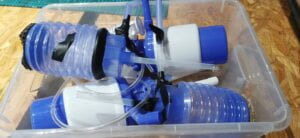 However, we couldn’t get it to work. I came up with the idea of using water bottles and straws to squeeze the water in and out. We first tried round bottles but they make too much noise. Then we decided to use quadrate water bottles. They’re easier to squeeze. We spent a lot of time trying out the right bottle, drilling holes, and stabling the tubes and the bottles together.
However, we couldn’t get it to work. I came up with the idea of using water bottles and straws to squeeze the water in and out. We first tried round bottles but they make too much noise. Then we decided to use quadrate water bottles. They’re easier to squeeze. We spent a lot of time trying out the right bottle, drilling holes, and stabling the tubes and the bottles together. 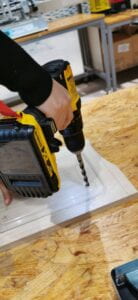
During the User Testing Session, users pointed out that the box was too low and participants didn’t really have an idea of what was going on. When they saw the two bottles, they didn’t know what to do. So I added arrowheads on the tubes to indicate which way the water should go. We also tried to direct the users of the squeezing process by the indication of the LED strip. We only had the words “arsonist” and “firefighter” at the beginning.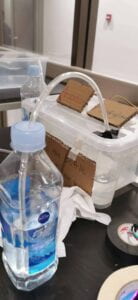 But Gohai suggested we should put on paintings or photos to demonstrate them more clearly.
But Gohai suggested we should put on paintings or photos to demonstrate them more clearly. 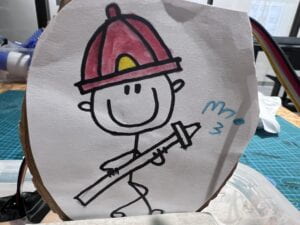 The adaptations we made were effective. Users know what they should do regardless of our explanations. Despite the fabrication, we also jointly work on the code and electronics. It took us a lot of time to get the code right.
The adaptations we made were effective. Users know what they should do regardless of our explanations. Despite the fabrication, we also jointly work on the code and electronics. It took us a lot of time to get the code right. - CONCLUSIONS. The goal of our project is to explore moisture sensors with the two-player game squeeze competition. My project result shows the interaction because it can use the sensor, the buzzer, and the LEDs to communicate with the users. However, the users can only squeeze the bottle. There’s nothing else they can do. It’d be better if users have more ways of communicating. My audience interacted with my project well. The problem was with the bottles. They can be hard to squeeze, and water might come out. The truth is that it’s not that the harder you squeeze, the more water you move. The key is the air. However, many users mistakenly believe that they need to squeeze hard to move the water. So hard that they damage the bottle. It’s not the case. If there were more time, I would find an alternative to the water bottle like the thing we use for blood pressure. It might be easier to squeeze, the outcome can be more obvious and there won’t be water spilling out.
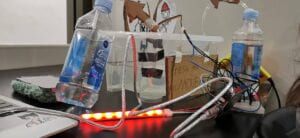 Our idea wasn’t easy to accomplish. One thing I learned from the setbacks is to accept the fact that our anticipation may not work out and we need to move to plan b. We decided to explore the messiest element when it comes to electric devices-water. Fortunately, we didn’t screw up. It was fantastic that we can use sensors and electronic devices to detect water.
Our idea wasn’t easy to accomplish. One thing I learned from the setbacks is to accept the fact that our anticipation may not work out and we need to move to plan b. We decided to explore the messiest element when it comes to electric devices-water. Fortunately, we didn’t screw up. It was fantastic that we can use sensors and electronic devices to detect water.
Video: